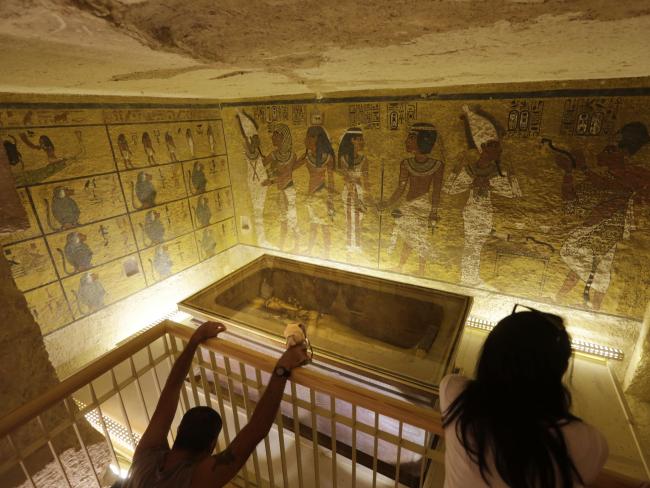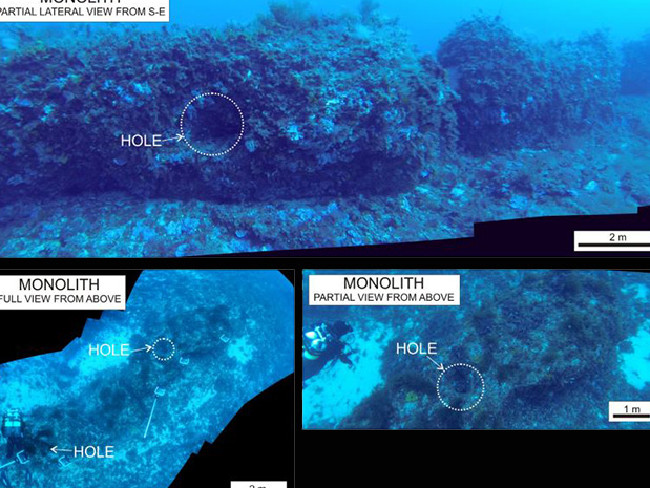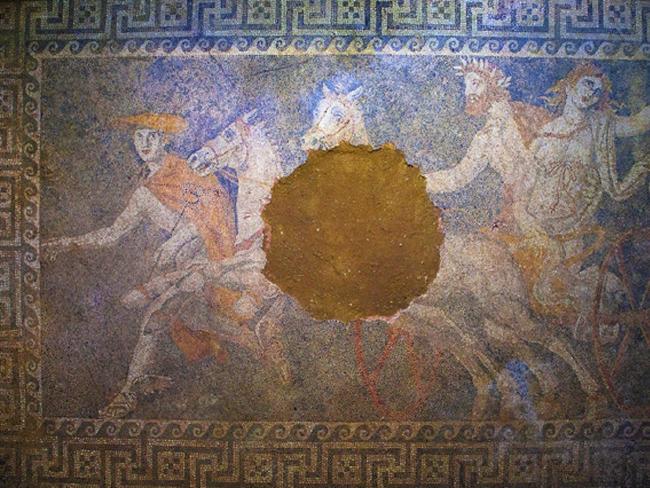
An artist’s impression of stone monoliths found buried near Stonehenge which could have been part of the largest Neolithic monument built in Britain, archaeologists believe. Pic: EPA/Stonehenge Hidden Landscape Project
THE top archaeological discoveries of 2015 offer fresh insight of cultures spanning eons. From the origins of Stonehenge to the secrets of King Tut’s tomb, many of history’s greatest mysteries have begun to be revealed.
STONEHENGE: WHEELS WITHIN WHEELS
Ongoing excavations surrounding Stonehenge continue to produce fresh insights to the thinking of the prehistoric peoples who built it. In recent months it has been discovered that the stone monument is actually the successor to a larger, more ancient nearby structure — Durrington Walls.
Archaeologists speculate the toppling and burial of standing stones at the older site, and the erection of Stonehenge nearby, may point to a dramatic shift in culture from one belief system to a solar cult.
But the most recent news is the discovery of the exact quarries from which Stonehenge’s distinctive bluestones were hewed.
The two rocky outcrops in Wales reveal the stones were actually cut some 500 years before Stonehenge was assembled.
This suggests the bluestones were part of another stone circle before they were dragged 225km to their new home.
Stay tuned in 2016 for the revelation as to where Stonehenge 1.0 was.

These 4,500-year-old stones, some measuring 4.5m in length, were discovered under one metre of earth at Durrington Walls "superhenge". Pic: EPA/Stonehenge Hidden Landscape ProjectSource:AAP
KING TUT’S FAMILY SECRETS
Take archaeology’s most famous find — the tomb of Pharaoh Tutankhamun. Add history’s most beautiful woman — Queen Nefertiti. What you get is one of the most exciting developments in Egyptology in generations.
Archaeologists now believes there may be more to Tutankhamun’s tomb than we believe. A scan of high-resolution images revealed odd depressions in two of its walls. Subsequent infra-red and radar scans appear to confirm the speculation: There are likely to be hidden doors behind the ancient murals.
Added to the mix is the recent re-examination of much of King Tut’s treasure. Why does so much of it appear to be ‘repurposed’? Are they hand-me-downs? Or objects stolen from an unpopular pharaoh’s tomb to decorate his own?
New analysis of King Tut’s famous golden death mask may offer a clue: It appears his name has been stamped over the top of another. Ankhkheprure Nefernefruaten.
Nefertiti.
This was the beautiful wife of the heretic king Akhenaten: A pharaoh who attempted to overthrow Egypt’s ancient gods and replace them with a single new one. The sun-god Aten.
Tutankhamun, his son, was a key player in restoring the old gods — and their priests — to power.

What lies beneath? ... The tomb of King Tut as it is displayed in a glass case at the Valley of the Kings in Luxor, Egypt. Pic: AP Photo/Amr NabilSource:AP
PYRAMID HOTSPOTS
Cosmic — and conventional — powers are being employed to unlock the secrets of Egypt’s pyramids. And they’re already producing tantalising traces of possible hidden chambers.
Egypt in November initiated the Scan Pyramids project, an exercise involving radar, infra-red and cosmic ray detectors to peer deep inside the enormous stone structures to learn more about their construction.
And the early results are exciting. Several ‘thermal anomalies’ have been identified inside the Great Pyramid of Cheops — the most famous of all the structures. These indicate areas that may be built of different materials, as well as possible ‘voids’ within the stone walls.
It is hoped further scans with radar and cosmic rays will further define these spaces, as well as find new areas of interest deeper within the mounds of rock.
But don’t expect any earth-shattering discoveries any time soon. Egyptian authorities say any further investigations would take years to initiate in order to avoid damaging the pyramids’ already fragile structures.

Hotspots ... Several ‘thermal anomalies’ have been identified inside the Great Pyramid of Cheops.
MEDITERRANEAN MONOLITH
A 12-metre long lump of limestone sitting on the bottom of the Mediterranean Sea wound not be all that strange, if it weren’t for the fact it had been hacked into shape by humans more than 9000 years ago.
It’s a discovery forcing archaeologists to reconsider their assessment of the technological know-how of ‘primitive’ hunter gatherers.
Surveys by divers reveal the 14 tonne monolith appears to have been hewed from a rocky ridge some 300m from its final resting place. That it was shaped by stone-age humans is beyond doubt: It has several holes drilled through its base.
It is possible it was abandoned where it lay after it split in two during transport to an as yet unknown destination.
How did the hewed stone block end up beneath 40 metres of water? The Mediterranean flooded some 9000 years ago as the last Ice Age retreated; inundating what was at the time a large archipelago between Sicily, Malta and Africa.

A mysterious underwater monolith has been discovered 60km off the coast of Sicily.Source:Supplied
AMPHIPOLIS IDENTITY
The discovery in 2014 of a burial chamber inside an enormous mound in northern Greece raised many questions. How was it linked to Alexander the Great? Was it built for his mother? His wife? One of his generals?
Ongoing excavations this year eventually produced an answer.
The tomb had proven difficult to decipher. While the statues and mosaics remained largely intact, there appeared to be no indication of who their original owner was.
The burial site itself had been disturbed several times in antiquity. An analysis of bones revealed up to five different individuals had been interred there.
But careful excavations eventually erased enough of the mud and debris accumulated over the eons to reveal repetitions of a particular monogram. This assembly of strokes contained the Greek letters of the name ΗΦΑΙΣΤΙΩΝ.
Hephaistion Amyntoros.
This was Alexander’s deputy commander, and close personal friend. Many believe he was the general’s long-term lover.
Historical sources reveal Alexander had ordered the erection of monuments and temples to the memory of his friend after Hephaistion’s death in 324BC. Alexander died himself just a year later.
It seems his orders were carried out.

Archaeologists digging through an ancient grave at Amphipolis, northern Greece, uncovered this 3-by-4.5 metre mosaic in what is likely the antechamber to the main burial room. Pic: AP Photo/Greek Culture MinistrySource:Supplied













